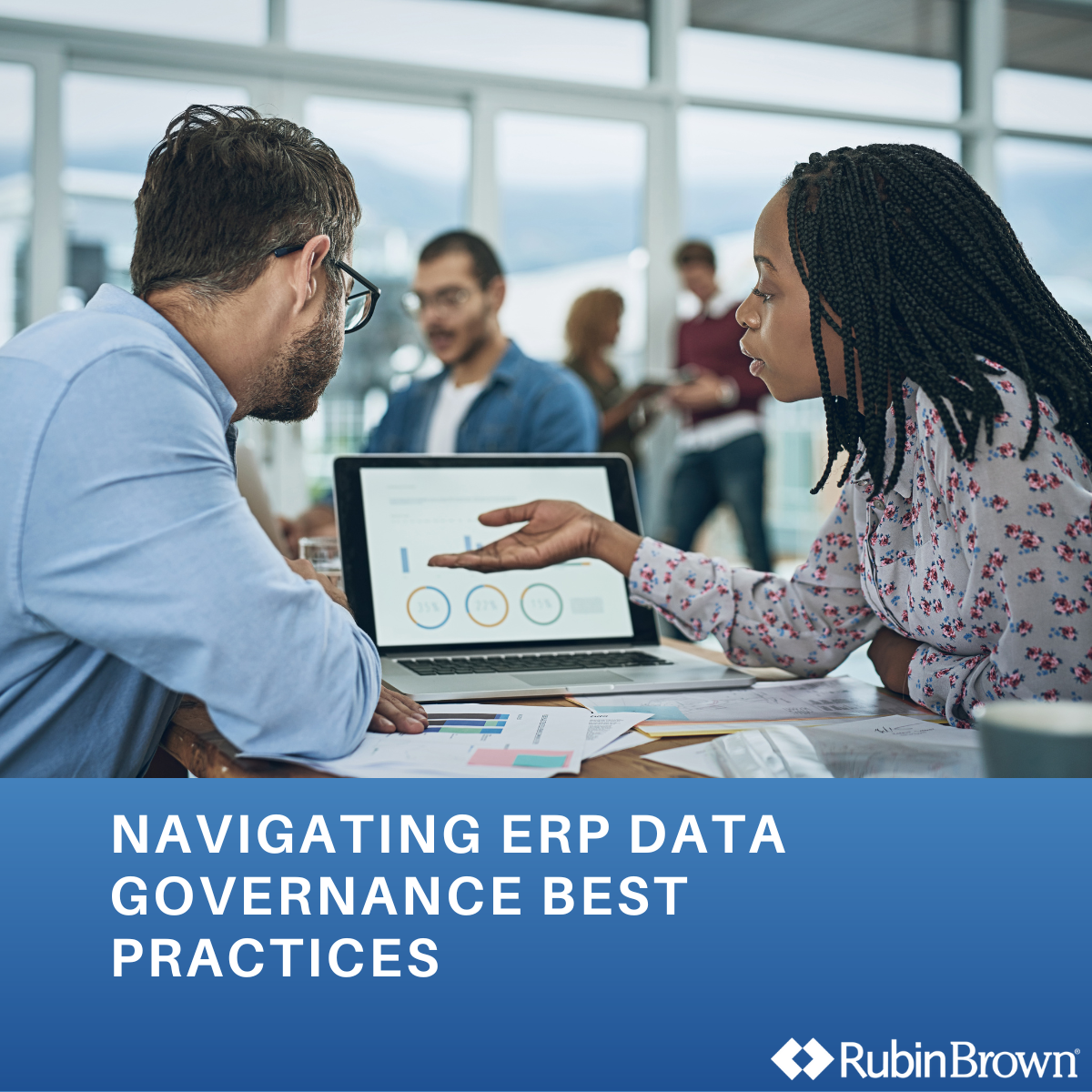Transforming Governance, Risk & Compliance: ERPs Revolutionize Biz Ops
In today's complex and highly regulated business environment, effective governance, risk management, and compliance (GRC) practices are essential for...

Implementing an Enterprise Resource Planning (ERP) system is a significant investment for any organization. However, even the most advanced ERP system is only as good as the data it relies on. Poor ERP data quality and governance can lead to costly errors, delays, and ineffective decision-making.
There are strategies to employ for avoiding the pitfalls of poor ERP data quality and governance, increasing the likelihood your ERP system can deliver its full potential.
Before implementing an ERP system or embarking on an ERP data governance initiative, it is essential to define a clear data strategy. This strategy should include:
Before migrating or inputting data into your ERP system, perform a comprehensive data quality assessment. This should include:
Data governance is the process of managing data assets, ensuring data quality, and aligning data practices with organizational goals.
Creating a dedicated team or committee to oversee data governance initiatives is crucial for ensuring the success and effectiveness of data management within an organization. This team should be comprised of individuals from various departments, including IT, business units, and data stewards and led by either a data governance manager or chief data officer.
The IT representatives will bring technical expertise and knowledge of systems and infrastructure to the team, helping to ensure that data governance policies and procedures are implemented effectively within the organization's IT systems. The business unit representatives will provide insight into the specific data needs and requirements of different departments, helping to tailor data governance initiatives to meet the organization's overall goals and objectives.
Data stewards, on the other hand, will play a key role in ensuring the quality and integrity of the organization's data. They will be responsible for defining data standards, monitoring data quality, and resolving any data-related issues that may arise.
By bringing together individuals with diverse skills and perspectives, the dedicated data governance team will be able to develop and implement comprehensive data governance strategies that align with the organization's overall objectives and priorities. This collaborative approach will help to ensure that data governance initiatives are successful and sustainable in the long term.
Developing and documenting data governance policies, procedures, and guidelines is essential for ensuring that an organization's data is managed effectively and securely. These policies should outline how data is accessed, stored, and used within the organization, as well as the security measures that are in place to protect it from unauthorized access or breaches.
Data governance policies should also address privacy concerns, ensuring that sensitive information is handled in accordance with relevant regulations and best practices. This includes defining who has data access, how it is shared, and how it is protected from potential threats.
In addition, data governance policies should address compliance requirements, ensuring that the organization is following all relevant laws and regulations related to data management. This includes requirements related to data retention, data sharing, and data security.
By developing and documenting data governance policies, procedures, and guidelines, organizations can ensure that their data is managed in a consistent and secure manner, reducing the risk of data breaches and ensuring compliance with relevant regulations.
Investing in data governance tools and software is essential for organizations looking to effectively manage their data assets across the organization. These tools can automate data lineage, which is the process of tracking the origin and movement of data throughout its lifecycle. By understanding where data comes from and how it is used, organizations can ensure data accuracy and integrity.
Additionally, data governance tools can track changes made to data, providing a clear audit trail of who made changes, when they were made, and why. This is crucial for data governance efforts and ensuring compliance with regulations such as GDPR and HIPAA.
Furthermore, these tools can also monitor data security and compliance in real-time, alerting organizations to any issues or anomalies that may arise. By proactively addressing data quality issues, organizations can prevent costly errors and ensure that their data remains accurate and reliable.
Overall, investing in data governance tools and software is a smart decision for organizations looking to employ data governance best practices and maximize the value of their data assets.
Data security is a fundamental aspect of data governance. Protect your ERP data from unauthorized access, breaches, and data leaks by:
An enterprise data governance program involves ongoing processes; therefore, you must establish a system for continuous monitoring and improvement.
Key performance indicators (KPIs) for data quality and governance are specific metrics that are used to measure the effectiveness of an organization's data management practices. These KPIs can include metrics such as data accuracy, completeness, consistency, and timeliness. By defining these KPIs, organizations can establish clear goals and benchmarks for their data governance solutions.
Regularly assessing these metrics is crucial for ensuring that policies and data standards are being met. By monitoring these KPIs on a consistent basis, organizations can identify any areas of concern or potential issues that may be impacting the overall quality of their data. This allows for proactive measures to be taken to address any issues before they escalate and impact the organization's operations.
When deviations or deficiencies are identified in the KPIs for data quality and governance, corrective actions should be taken promptly to address the root cause of the issue. This may involve implementing new processes or procedures, providing additional training to staff, or investing in new technology or tools to improve data governance practices.
By taking corrective actions in a timely manner, organizations can ensure that their data remains accurate, reliable, and compliant with regulatory requirements.
Encouraging users to provide feedback on data quality issues they encounter is essential for maintaining accurate and reliable data. By actively seeking input from users, organizations can identify areas for improvement and address any issues that may be affecting the quality of their data. Implementing a system for reporting and resolving data-related problems can help streamline the process of addressing issues and ensure that they are resolved in a timely manner.
This system can include a designated point of contact for reporting issues, a clear process for investigating and resolving problems, and regular communication with users to keep them informed of the status of their reported issues. By prioritizing data quality and actively seeking feedback from users, organizations can ensure that their data remains accurate, reliable, and valuable for decision-making purposes.
Training employees on effective data governance is essential for ensuring that data within an organization is accurate, reliable, and consistent. By regularly educating staff on the importance of data governance, organizations can empower their employees to understand the significance of maintaining high-quality data.
Knowledgeable staff serve as the first line of defense against data protection issues by being able to identify and address potential problems before they escalate. They can also help to establish and enforce data privacy and security standards and procedures within the organization, ensuring that data is managed effectively and in compliance with regulations.
By investing in employee training and development in data stewardship, organizations can improve the overall quality of their data, enhance decision-making processes, and ultimately drive better business outcomes. Additionally, well-trained employees are more likely to take ownership of data quality throughout the data lifecycle and actively contribute to maintaining high standards within the organization.
Avoiding poor ERP data quality and governance is essential for maximizing the benefits of your ERP system. By developing a clear data strategy, conducting data assessments, investing in data governance, enforcing data security measures, and maintaining a culture of continuous improvement, your organization can ensure that its ERP data remains accurate, reliable, and aligned with your business objectives.
In doing so, you'll not only enhance operational efficiency but also gain a competitive edge in today's data-driven business environment.
Need support with your data? Check out our IT and Data services and contact us for your tailored plan.
This post has been updated and expanded upon since its original posting in September 2023.

In today's complex and highly regulated business environment, effective governance, risk management, and compliance (GRC) practices are essential for...

4 min read
The Colorado Artificial Intelligence Act (SB 24-205) marks a pivotal moment for healthcare organizations, introducing regulatory requirements that...

Enterprise Resource Planning (ERP) systems play a crucial role in the manufacturing industry by helping organizations streamline their operations,...